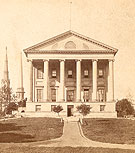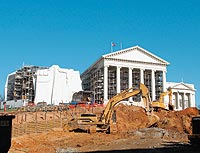Giving Old Buildings a Reason to Live
Virginia State Capitol
Working on the Virginia State Capitol in Richmond is no trivial matter. Designed to reflect the values of democracy by founding father Thomas Jefferson, the original edifice was constructed between 1785 and 1798. It was the first public building in America to reflect the Classical Revival style and quickly became the model for many civic buildings that have since appeared across the United States. Today's expanded complex houses what is now the oldest, continuous, English-speaking, lawmaking body in the western world.
With so much history at stake, it's only fitting that George C. Skarmeas, AIA, director of historic preservation at Hillier Architecture, approaches the current restoration and expansion effort-- scheduled for completion by the end of 2006-- with great deference and care: "We have momentary custody of this building. By maintaining the highest standards of treatment, we can assure the history of the Capitol for generations to come."
|
Jefferson's approximately 29,000-square-foot structure was erected on Shockoe Hill, in the center of what came to be called Capitol Square. Its famed South Portico-with classical pediment spanning six Ionic columns above a cascading set of steps-overlooked the James River. At first glance one would assume that the entrance to this dignified building was through the grand portico, but in fact the major entries were set in the middle of the east and west facades. These entrances led through central corridors to a domed, two-story rotunda that has, since 1796, been dominated by a life-size marble statue of George Washington by French artist Jean-Antoine Houdon. The assembly rooms for the House of Delegates and the Senate originally flanked this central zone on the north and south, respectively.
As the country grew, so did the State Capitol. Between 1904 and 1906, larger double-height assembly chambers were added to the east and west, connected via very narrow passageways to the side entrances of the original building. These connectors were widened between 1962 and 1964, at which point the entire complex measured about 75,000 square feet.











